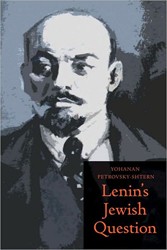By
– August 31, 2011
Reading this intriguing book reminded the reviewer of heartfelt comments from Jewish former Communists in Paterson, New Jersey, some years ago: “We never hurt anybody. We only tried to do good things.”
Like the other Yiddishist “CP” members and “sympathizers,” Prof. Srebrnik, a British scholar, studied intensively. Ardent supporters of Russian Communism, they were thrilled at the suggestion that a national home in eastern Russia (Siberia) might be carved out for Jews fleeing from the Nazi peril. The author painstakingly details the fundraising efforts of Jewish American CP groups, and their gifts of machinery, medical equipment, children’s clothing, even a complete dental office. Birobidzhan, the designated site, was to be a Yiddish-speaking gem of the labor movement, in preference to “fascistic” capitalist Israel, which was sure to fail.
Visiting was not permitted, but the donors were given glowing descriptions of a bustling cultural center with hospitals, universities, theaters, factories, and outlying agricultural areas.
Finally, in 1954, an American newspaper report revealed that, with few Jewish residents, Birobidzhan was actually a crude outpost. Russian was the popular language there. Asking why the project had failed, the author suggests that the emphasis on building socialism had overshadowed any gestures at creating a Jewish flavor.
After revelations of virulent anti-Semitism at the highest political levels in the Soviet Union, “The Movement” in the U.S. died a natural death. Most members now supported Israel and other Jewish causes. Prof. Srebrnik contends that McCarthy simply dealt a final blow to the Jewish far-left on top of massive disillusion.
Academic libraries should, of course, stock this well-researched volume. But if the contents are made clear beyond the cover, it should attract all kinds of readers.
Abbreviations, appendix, index, introduction, list of illustrations, preface, selected bibliography, table of contents.
Like the other Yiddishist “CP” members and “sympathizers,” Prof. Srebrnik, a British scholar, studied intensively. Ardent supporters of Russian Communism, they were thrilled at the suggestion that a national home in eastern Russia (Siberia) might be carved out for Jews fleeing from the Nazi peril. The author painstakingly details the fundraising efforts of Jewish American CP groups, and their gifts of machinery, medical equipment, children’s clothing, even a complete dental office. Birobidzhan, the designated site, was to be a Yiddish-speaking gem of the labor movement, in preference to “fascistic” capitalist Israel, which was sure to fail.
Visiting was not permitted, but the donors were given glowing descriptions of a bustling cultural center with hospitals, universities, theaters, factories, and outlying agricultural areas.
Finally, in 1954, an American newspaper report revealed that, with few Jewish residents, Birobidzhan was actually a crude outpost. Russian was the popular language there. Asking why the project had failed, the author suggests that the emphasis on building socialism had overshadowed any gestures at creating a Jewish flavor.
After revelations of virulent anti-Semitism at the highest political levels in the Soviet Union, “The Movement” in the U.S. died a natural death. Most members now supported Israel and other Jewish causes. Prof. Srebrnik contends that McCarthy simply dealt a final blow to the Jewish far-left on top of massive disillusion.
Academic libraries should, of course, stock this well-researched volume. But if the contents are made clear beyond the cover, it should attract all kinds of readers.
Abbreviations, appendix, index, introduction, list of illustrations, preface, selected bibliography, table of contents.
Jane Wallerstein worked in public relations for many years. She is the author of Voices from the Paterson Silk Mills and co-author of a national criminal justice study of parole for Rutgers University.





